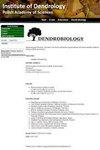乌克兰东喀尔巴阡山脉高山木本植物的生物多样性
IF 1.8
4区 农林科学
Q2 FORESTRY
引用次数: 1
摘要
欧洲山脉的最高部分被亚高山和高山植被覆盖,植物区系丰富,包含许多适应寒冷温度和相对较短植被期的木本植物遗迹。在乌克兰喀尔巴阡山脉,只有几座最高的山脉形成了适合高山植物生长的环境条件。该研究的目的是检测乌克兰东喀尔巴阡山脉高山植物生物多样性的中心。我们预计乌克兰东喀尔巴阡山脉中最多的高山木本物种将出现在该国最大和最高的山脉Chornohora。为解决这一问题,对16种木本植物的地理分布进行了制图分析。收集了分布于亚高山和高寒植被带的919个类群点的地理参考资料,利用QGIS软件编制了类群分布图。此外,我们还分析了每个分类单元在不同展示台上的垂直分布和发生情况。所分析的亚高山和高山物种大多发生在最高和最大的山体上。高山木本树种出现在东喀尔巴阡山脉的乌克兰部分,主要是在最大的山脉,Chornohora, Svydovets, Chyvchyny, Marmarosh,以及较小程度上,也在Gorgany。大多数亚高山和高寒物种的垂直分布和主要分布在北部或靠近北部的出口,表明它们需要相对高的土壤湿度和高水平的降水。这些条件表明,所分析的大多数物种具有遗迹特征,它们起源于更新世冰期。这些分类群的分布中心位于乌克兰境内东喀尔巴阡山脉的高山和亚高山植被带,它们是乌克兰植物区系中宝贵但受到威胁的组成部分。本文章由计算机程序翻译,如有差异,请以英文原文为准。
Biodiversity of high-mountain woody plants in the East Carpathians in Ukraine
The highest parts of the European mountain massifs are covered by subalpine and alpine vegetation, with rich flora containing many relic woody plants adapted to cold temperatures and relatively short vegetation periods. In the Ukrainian Carpathians, only several highest mountain massifs form environmental conditions suitable for high mountain plants. The aim of the study was the detection of the centre of biodiversity of the high mountain plants in the East Carpathians in Ukraine. We expected the largest number of high mountain woody species in the Ukrainian East Carpathians would occur in the Chornohora, the largest and most elevated mountain chain in the country. To solve this problem, the geographic distribution of 16 woody species was analysed cartographically. We gathered georeferenced data of 919 localities of taxa, which occur in the subalpine and alpine vegetation belts, and prepared maps of their distribution using QGIS software. Additionally, we analysed vertical distribution and occurrence on different expositions of every taxon. Most of analysed subalpine and alpine species occur in the highest and the largest mountain massifs. The high mountain woody species occur in the Ukrainian parts of the East Carpathians mainly in the largest mountain massifs, the Chornohora, Svydovets, Chyvchyny, Marmarosh, and to a lesser extent, also in the Gorgany. The vertical distribution and predominant occurrence on the northern or close to northern expositions of most subalpine and alpine species indicate their demands for the relatively high level of humidity of the soil and high level of precipitation. These condition point to the relic character of most of analysed species, which origin from the glacial periods of the Pleistocene. Most of the taxa, which have centres of their distribution in the alpine and sub-alpine vegetation belts of the East Carpathians in the Ukraine territory are valuable but threatened elements of the Ukrainian flora.
求助全文
通过发布文献求助,成功后即可免费获取论文全文。
去求助
来源期刊

Dendrobiology
农林科学-林学
CiteScore
2.20
自引率
11.10%
发文量
17
审稿时长
>12 weeks
期刊介绍:
Dendrobiology publishes original research articles and review articles related to the biology of trees and shrubs.
 求助内容:
求助内容: 应助结果提醒方式:
应助结果提醒方式:


